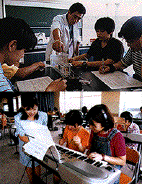|
Science & Technology || Sports & Fashion || Search || Back Numbers
GRADELESS HIGH SCHOOLS: Schools Diversifying under the Credit System May 18, 1998  Credit-system schools give students a chance to study different subjects in a freer environment. (Photos: Kanagawa Sohgoh High School) No grade levels, advancement by credits, and free choice of courses are the features of Japanese high schools running under the credit system. The system was introduced in Japan ten years ago to allow a more liberal education that respects individuality and differences of students' interests; now there are 170 such schools, both public and private. How the curriculum and schedule are determined differs widely from school to school, but students seem to find the basic idea of freely choosing their own courses highly attractive, and the number of applicants for credit-system high schools is rising. From Full Freedom to Tuning Up for University Exams Japanese high schools are normally divided into three grade levels. The school decides on the course schedule, which is applied more or less uniformly to all students in the same grade. Under the credit system, in contrast, high schools are not divided into grade levels, and the time required for graduation is three years or more. The students are also free to choose which courses to take. But aside from these basic features, high schools under the credit system are increasingly diversifying. For example, a prefectural high school founded in 1995 in Kanagawa Prefecture, neighboring Tokyo, posts the course list by day and time, much like a university. The students are responsible for putting together their own schedule. Those who have no morning classes can come to school in the afternoon, and if classes end early they are free to go home. The school offers a total of 154 courses; students are required to take certain courses to graduate, but 65 of the elective courses are in subjects including volunteering, stage performance, and engineering, which are not usually taught at the high-school level. Students can choose from an array of foreign languages that includes not only English but also Chinese, German, and Spanish, among others. At the other end of the spectrum is another prefectural high school in Nara Prefecture, near Osaka, where 90% of graduates advance to four-year universities. This school adopted the credit system in 1995, but has incorporated it in such a way that the students' freedom of choice gradually increases, aiming to facilitate effective course selection toward university entrance exams. The teachers construct the schedule after receiving course applications from all of the students. The hours are unchanged from the old system, with six classes a day from Monday through Friday and four on Saturday. The school advises the students to fill their schedule during the first two years; they are allowed up to four hours of free time per week in their third year, but are expected to use this time to study on their own. The evaluation of the system is just as varied. Students enrolled in credit-system high schools are expected to go to the appropriate classrooms rather than stay in one room while the teachers move around. The dominant opinion among educators in the field, therefore, is that in exchange for the freedom, this demands initiative and strict self-discipline on the part of the students. Some students who cannot find a concrete goal may stop coming to school or drop out altogether. Thus, they say, offering proper student guidance at these high schools is more difficult than at regular schools. On the other hand, alternatives like retaining the same regulations as the regular system and gearing the curriculum to university entrance exams invite just as much criticism. Although ten years have passed since their inception, credit-system high schools still seem to be at a stage of trial and error. Nevertheless, many students are drawn by the prospect of selecting courses that suit their individual goals. Spurred on by this popularity, the trend continues as a succession of high schools move to join the growing credit-system flock.
 Edited by Japan
Echo Inc. based on domestic Japanese news sources. Articles
presented here are offered for reference purposes and do not
necessarily represent the policy or views of the Japanese
Government. Edited by Japan
Echo Inc. based on domestic Japanese news sources. Articles
presented here are offered for reference purposes and do not
necessarily represent the policy or views of the Japanese
Government.
|
